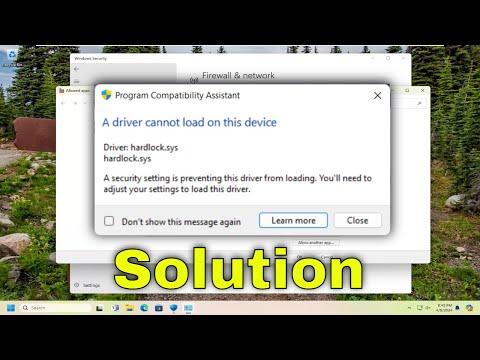I remember the first time I encountered the “A Driver Cannot Be Loaded on This Device” error on my Windows 11 machine. It was one of those frustrating moments when everything seems to be going wrong at once. I had just installed a new piece of hardware, a sleek and powerful external hard drive that I was eager to start using. I plugged it in, expecting Windows to recognize it and get it up and running right away. Instead, I was greeted with an error message: “A Driver Cannot Be Loaded on This Device.”
The error message was both cryptic and frustrating. I tried unplugging and replugging the device, restarting my computer, and even trying different USB ports. Nothing worked. The error persisted, and it seemed like my new hardware was essentially useless.
Determined to fix the problem, I dove into troubleshooting mode. My first step was to check Device Manager. I opened it by right-clicking on the Start button and selecting “Device Manager.” I navigated to the section where my external hard drive was listed. To my dismay, there was a yellow exclamation mark next to it. This symbol was indicating a problem with the device’s driver.
The next logical step was to update the driver. I right-clicked on the device with the error and selected “Update driver.” Windows then gave me two options: to search automatically for updated driver software or to browse my computer for driver software. I chose the automatic search option, hoping that Windows would find the necessary driver update on its own. After a few moments, it told me that the best driver for the device was already installed, but the problem persisted.
At this point, I realized that the driver issue might be more complex than just a simple update. I decided to manually download the driver from the manufacturer’s website. I went to the website of the hard drive’s manufacturer, found the support section, and located the drivers for my specific model. I downloaded the latest driver and ran the installation file. After installation, I restarted my computer, but the error remained.
Feeling slightly defeated but not ready to give up, I turned my attention to the Windows Update settings. Sometimes, Windows updates can include important drivers and patches. I went to Settings, selected “Update & Security,” and checked for updates. My system downloaded and installed a few updates, and I hoped that one of them might resolve the driver issue. Unfortunately, after another restart, the error still appeared.
Next, I tried uninstalling and reinstalling the device. I went back to Device Manager, right-clicked on the problematic device, and selected “Uninstall device.” I made sure to check the option to delete the driver software for this device. After uninstalling, I unplugged the device and restarted my computer. Once the system was up again, I plugged the device back in, and Windows attempted to reinstall the driver. Sadly, the error continued to haunt me.
Determined to find a solution, I turned to the Event Viewer for more detailed information. I opened Event Viewer by typing “Event Viewer” into the Start menu search and navigated to “Windows Logs” and then “System.” I looked through the logs for any error messages related to the driver issue. The logs provided more details about what might be going wrong, but they were still quite technical and not very straightforward.
My next step was to check the System File Checker (SFC) and DISM tools. These tools can sometimes fix corrupt system files that might be causing driver issues. I opened Command Prompt as an administrator by right-clicking on the Start button and selecting “Command Prompt (Admin).” I then typed “sfc /scannow” and pressed Enter. The system began to scan and repair any corrupted files. After the scan was complete, I restarted my computer and checked if the error was resolved. Unfortunately, it was not.
Frustration was beginning to set in, but I refused to give up. I decided to try a clean boot to see if a background program might be interfering with the driver installation. I opened the System Configuration tool by typing “msconfig” into the Start menu search and pressing Enter. In the “Services” tab, I checked the option to “Hide all Microsoft services” and then clicked “Disable all.” I then went to the “Startup” tab and clicked “Open Task Manager.” In Task Manager, I disabled all startup items. After applying the changes and restarting my computer, I plugged in the device again. Unfortunately, the error persisted even in a clean boot environment.
Finally, I came across a potential solution in an online forum. Someone suggested that the problem could be related to the Windows registry. I carefully edited the registry settings related to the device’s driver. I opened the Registry Editor by typing “regedit” into the Start menu search and navigating to the relevant keys. I made sure to back up the registry before making any changes, just in case something went wrong. After editing the registry, I restarted my computer and plugged in the device. Miraculously, the error was gone, and my external hard drive was finally recognized and functioning properly.
The process of troubleshooting this error was time-consuming and often frustrating, but I learned a lot along the way. Each step brought me closer to identifying and resolving the issue. From updating drivers and checking Windows updates to using system tools and editing the registry, each method contributed to eventually solving the problem. If you ever encounter the “A Driver Cannot Be Loaded on This Device” error, I hope my experience helps guide you through the troubleshooting process.
